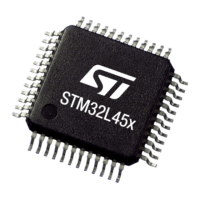Table 107. ATIM_SM_0
SM CODE ATIM_SM_0
Description Periodic read-back of configuration registers
Ownership End user
Detailed implementation
This method must be applied to advanced, general-purpose and low-power timer configuration
registers.
Detailed information on the implementation of this method can be found in
Section 3.6.14 Extended interrupt and events controller (EXTI).
Error reporting Refer to NVIC_SM_0
Fault detection time Refer to NVIC_SM_0
Addressed fault model Refer to NVIC_SM_0
Dependency on Device configuration Refer to NVIC_SM_0
Initialization Refer to NVIC_SM_0
Periodicity Refer to NVIC_SM_0
Test for the diagnostic Refer to NVIC_SM_0
Multiple-fault protection Refer to NVIC_SM_0
Recommendations and known limitations Refer to NVIC_SM_0
Table 108. ATIM_SM_1
SM CODE ATIM_SM_1
Description 1oo2 for counting timers
Ownership End user
Detailed implementation
This method implements via software a 1oo2 scheme between two counting resources.
The guidelines for the implementation of the method are the following:
• Two timers are programmed with same time base or frequency.
• In case of timer use as a time base: use in Application software one of the timer as time
base source, and the other one just for check. Coherence check for the 1oo2 is done
at application level, comparing two counter values each time the timer value is used to
affect safety function.
• In case of interrupt generation: use the first timer as main interrupt source for the service
routines, and the second timer as a “reference” to be checked at the initial of interrupt
routine.
Error reporting Depends on implementation
Fault detection time Depends on implementation
Addressed fault model Permanent/transient
Dependency on Device configuration None
Initialization Depends on implementation
Periodicity On demand
Test for the diagnostic Not applicable
Multiple-fault protection CPU_SM_0: Periodic core self-test software
Recommendations and known limitations
Tolerance implementation in timer checks is recommended to avoid false positive outcomes of
the diagnostic.
This method applies to timer channels merely used as elapsed time counters.
UM2305
Hardware and software diagnostics
UM2305 - Rev 10
page 62/110

